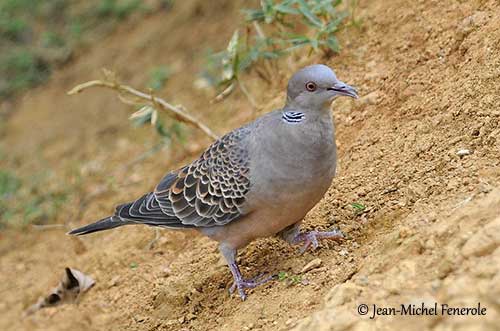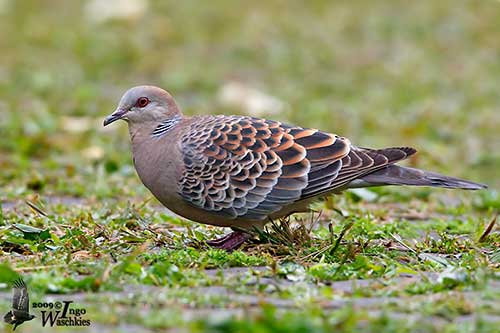
PROTECTION / THREATS / STATUS:
The Oriental Turtle-Dove is affected by predation during the nesting period, especially by the Carrion Crow and the Asian Azure-winged Magpie, but also by cats and snakes. The adults usually perform distraction displays, feigning an injury to lead the predators away from the nest. The species is also affected by over hunting in some regions, usually close to human settlements.
The Oriental Turtle-Dove is generally common throughout most of both breeding and wintering range. The population size is unknown, but it is suspected to be stable.
The Oriental Turtle-Dove is not globally threatened, and currently evaluated as Least Concern.
Fr: Tourterelle orientale
Ang: Oriental Turtle-Dove
All: Orientturteltaube
Esp: Tórtola Oriental
Ita: Tortora orientale
Nd: Oosterse Tortel
Sd: större turturduva
Photographers :
Didier Buysse
Vision d’Oiseaux
Jean Michel Fenerole
Photos d’Oiseaux du monde
Ingo Waschkies
Bird Photography
Text by Nicole Bouglouan
Sources:
HANDBOOK OF THE BIRDS OF THE WORLD vol 4 by Josep del Hoyo-Andrew Elliott-Jordi Sargatal - Lynx Edicions - ISBN: 8487334229
PIGEONS AND DOVES by David Gibbs, Eustace Barnes and John Cox - Pica Press Sussex - ISBN: 1873403607
Birds of Central Asia De Raffael Ayé, Manuel Schweizer, Tobias Roth - Bloomsbury Publishing, 2012 – ISBN: 1408142716, 9781408142714 – 336 pages
Birds of Nepal: Revised Edition De Richard Grimmett, Carol Inskipp, Tim Inskipp, Hem Sagar Baral - Bloomsbury Publishing, 2016 – ISBN: 1472925688, 9781472925688 – 386 pages
Bird Research News Vol.3 No.8 - Oriental Turtle Dove
Thai National Parks - Oriental Turtle Dove
What Bird-The ultimate Bird Guide (Mitchell Waite)
Wikipedia, the free encyclopaedia
Oriental Turtle-Dove
Streptopelia orientalis
Columbiformes Order – Columbidae Family
INTRODUCTION:
The Oriental Turtle-Dove has a wide range from Europe, E across Asia and Japan. Six subspecies are recognized. They slightly differ in plumage pattern and colour intensity.
This species may occur in a variety of habitats including forest edges and partly wooded farmland, from the subalpine zone to the urban areas. It forages in cultivated fields where it feeds on seeds and grains.
They are monogamous. The nest is a typical flimsy platform of twigs, built in tree or bush. Both parents share the nesting duties.
The Oriental Turtle-Dove is usually common and widespread throughout the range, and the species is not globally threatened for the moment.
DESCRIPTION OF THE BIRD:
Biometrics:
Length: 33-35 cm
Weight: 165-274 g
The Oriental Turtle-Dove is very similar to the European Turtle-Dove.
On the upperparts, the hindneck is dark grey with rufous-buff edges to feathers. On the mantle, feathers are similar to hindneck but with dark centres. Wing-coverts, scapulars and inner secondaries show more extensive black centres than in European Turtle-Dove. Inner secondaries and scapulars have chestnut edges. The primaries are black with pale edges. The chestnut fringes of wing-coverts tend to line up to form wingbars. The rump is dark bluish-grey. The uppertail-coverts are dark grey with paler tips. On the tail, central rectrices are blackish-grey, whereas outer rectrices are black with broad, slate grey terminal band.

On the underparts, chin and throat are pale buff. Neck and breast are mostly greyish-white. We can see a black patch on each side of the neck. The aligned feathers show conspicuous pale blue-grey tips. The area from breast to belly is dull vinous, shading into pale buff. The undertail-coverts are pale grey. On the underwing, the coverts are slate grey but more blackish on flight-feathers.
On the head, the forehead is buffy-grey and the blue-grey crown shades into dark grey-brown on nape and mantle. The face is washed pinkish.
The bill has dark purplish-red base and gape edges, and the tip varies from black or grey to brownish-horn. The eyes are orange-yellow, but they may vary from pale red to orange-red to orange or golden. They are surrounded by dark pinkish orbital skin. Legs and feet are reddish-purple with brown claws.
The female resembles male but she is duller and browner on neck and breast.
The juvenile is paler than adults and lacks the dark neck-patch. Wings and breast are edged with rufous-buff.
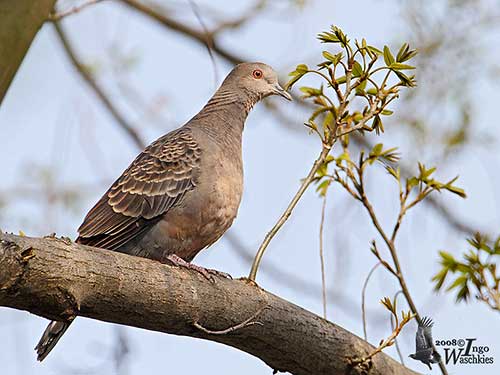
SUBSPECIES AND RANGE:
The Oriental Turtle-Dove has six subspecies that differ in plumage pattern and colour intensity.
S. o. meena breeds in S part of W Siberia to W Altai, S to Turkestan, Afghanistan, Kashmir and Himalayas E to C Nepal. Breeding range extends marginally into W Palearctic in the Ural Mts. It winters mainly in W and S India and Sri Lanka. This race is brighter than nominate with vinous foreneck and breast, whereas belly is pink and undertail-coverts are white.
The tail has narrower terminal white tail band (12 mm).
S. o. orientalis (described above) breeds in C Siberia E to Sakhalin, Kuril Is, Japan and Korea, and S through much of China to N Indochina. It winters in NW India and SE Asia.
S. o. stimpsoni occurs on Ryukyu Islands. This race has darker underparts.
S. o. orii is in Taiwan. This one is duller than nominate.
S. o. erythrocephala is found in Indian Peninsula (mainly C India and also Western and N Eastern Ghats).
This race is smaller and has more rufous underparts, neck and head are pinkish rufous and the breast is rusty pink.
S. o. agricola occurs in NE India, E to Myanmar and SC China. This one is more rusty than nominate but less than previous.
HABITAT:
The Oriental Turtle-Dove is often seen near cultivated areas and the species usually occurs from lowlands to mountains up to 2,400 metres on Mt Fuji, and higher in Nepal, up to 4,000 metres of elevation.
However, this species frequents a wide variety of habitats including forest edges, sparse woodland, scrub and wooded farmland near agricultural areas. It is also increasing in urban areas. It breeds in mixed forests and also in bamboo forests in foothills, depending on the range.
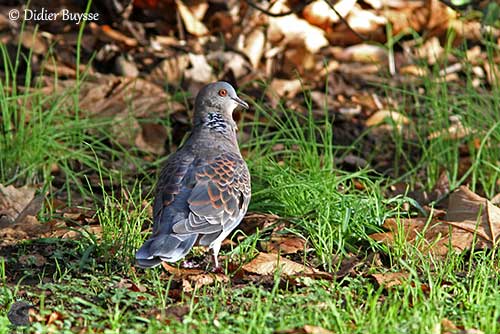
CALLS AND SONGS: SOUNDS BY XENO-CANTO
The Oriental Turtle-Dove gives a hollow and cooing “HROO-hroo hoo-hoo”. The nominate race utters a four-notes call “deh-deh co-co” but this song is geographically variable, becoming a two-notes call with low, resonant and harsh “hoo-boo, hoo-boo, hoo-boo…”.
The race “meena” has hoarse, rather mournful “goor…gur-grugroo”. In SE Asia, the race “agricola” utters a raucous “wu, whrroo-whru ru” with minor variations.
These advertising calls are continuously repeated during the breeding season.
BEHAVIOUR IN THE WILD:
The Oriental Turtle-Dove feeds mainly on the ground and often gleans grains from cultivated areas. But it also feeds on grass, bamboo and weed seeds, and green shots are also part of the diet. It can be seen foraging on dusty tracks and in open country.
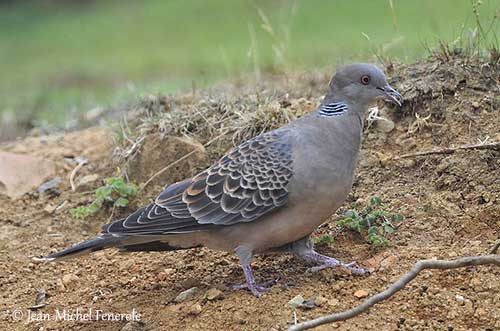
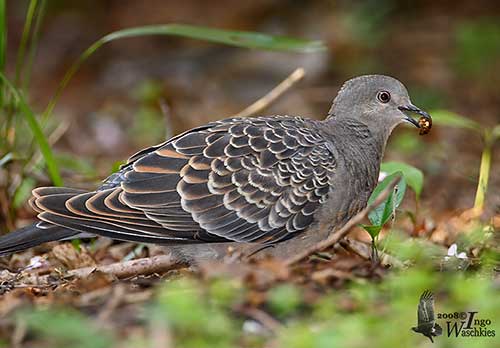
It is found alone, or in pairs during the breeding season. They often form small groups during winter and larger flocks during migrations.
The courtship displays are typical of the family Columbidae, with the male flying steeply up with clapping wingbeats, then gliding back to the perch while forming a wide arc in the air. During this display, the tail is fanned and the wings stretched forwards.
During the bowing display, the male approaches the female with hopping gait while bobbing the head and the neck is inflated. They are monogamous.
The nest is typically flimsy and placed in tree or bush. Both adults share the nesting duties.
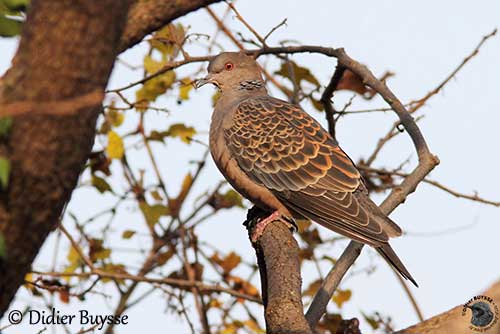
The southernmost populations are resident, but the northern birds migrate southwards to spend the winter in India and SE Asia.
Vagrants are regularly recorded in W Palearctic countries including the British Isles, Spain and Egypt. The nominate race is a rare vagrant in W North America, with some records from Alaska, British Columbia and California. It is also a casual visitor to the W Aleutian Islands and elsewhere in the Bering Sea.
The flight is strong, swift and direct, although relatively heavy.
REPRODUCTION OF THIS SPECIES:
The breeding season takes place between May and August in North, and between November and February in S India.
The Oriental Turtle-Dove is monogamous. The nest is a flimsy platform made with twigs in about four days. It is placed in tree or bush, between the ground and ten metres, often three metres above the ground, but sometimes 50 centimetres in a bush.
The female lays two small, white eggs and both adults incubate during 14-16 days, the female at night and the male during the day.
The chicks are still brooded during the first four days. They are dark grey with sparse yellow down. They are fed with regurgitated crop-milk directly into the bill. The young are gradually fed on grass seeds and grains. They leave the nest 14-17 days after hatching, but they still depend on adults for food during some time. Several broods are laid during the season.
